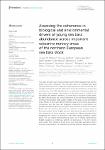Assessing the coherence in biological and environmental drivers of young sea bass abundance across important estuarine nursery areas of the northern European sea bass stock
| dc.contributor.author | Watson, JW | |
| dc.contributor.author | Radford, Z | |
| dc.contributor.author | Bannister, H | |
| dc.contributor.author | Bradley, R | |
| dc.contributor.author | Brown, M | |
| dc.contributor.author | Ciotti, BJ | |
| dc.contributor.author | Goodwin, D | |
| dc.contributor.author | Graham, JA | |
| dc.contributor.author | Nash, RDM | |
| dc.contributor.author | Roche, WK | |
| dc.contributor.author | Wogerbauer, C | |
| dc.contributor.author | Hyder, K | |
| dc.date.accessioned | 2024-01-24T22:46:03Z | |
| dc.date.available | 2024-01-24T22:46:03Z | |
| dc.date.issued | 2024-01-10 | |
| dc.identifier.issn | 2296-7745 | |
| dc.identifier.issn | 2296-7745 | |
| dc.identifier.uri | https://pearl.plymouth.ac.uk/handle/10026.1/21964 | |
| dc.description.abstract |
Year class strength is an important determinant of fish population size, but the drivers are often unknown. The northern stock of European sea bass (<jats:italic>Dicentrarchus labrax</jats:italic>) is an important target species for both commercial and recreational fisheries. Scientific assessments showed a rapid decline in spawning stock biomass from 2010-18 attributed to a combination of fishing mortality and poor year class strength. Recruitment to the adult stock is linked to the abundance and temporal dynamics of young bass in estuarine nursery areas, but little is known about the relative importance of environmental and biological drivers on the survival of these young life stages. In this study, we use Generalised Linear Models to attempt to identify important local environmental (sea surface temperature and river flow) and biological (chlorophyll-<jats:italic>a</jats:italic> concentration and predator abundance) drivers of young sea bass abundance. We focus on seven British and Irish estuarine areas that are important to the northern stock of European sea bass. In four English estuarine areas there were good model fits to the abundance of young sea bass, but predictors differed amongst these suggesting that drivers of abundance may differ among individual nursery areas. This was further demonstrated by poor fits of models generated for English estuaries to interannual patterns of abundance in the Irish nursery areas tested. The differences found in the most important abundance drivers amongst areas highlight the complex and differing dynamics between estuaries. If the number of young bass that eventually join the adult stock is dependent on survivors from a diverse set of unique nursery area conditions, then endeavours to incorporate this knowledge into fisheries management should be further explored. | |
| dc.format.extent | 1209311- | |
| dc.publisher | Frontiers Media SA | |
| dc.subject | 3708 Oceanography | |
| dc.subject | 31 Biological Sciences | |
| dc.subject | 3103 Ecology | |
| dc.subject | 37 Earth Sciences | |
| dc.subject | 3705 Geology | |
| dc.title | Assessing the coherence in biological and environmental drivers of young sea bass abundance across important estuarine nursery areas of the northern European sea bass stock | |
| dc.type | journal-article | |
| dc.type | Journal Article | |
| plymouth.volume | 10 | |
| plymouth.publication-status | Published online | |
| plymouth.journal | Frontiers in Marine Science | |
| dc.identifier.doi | 10.3389/fmars.2023.1209311 | |
| plymouth.organisational-group | |Plymouth | |
| plymouth.organisational-group | |Plymouth|Faculty of Science and Engineering | |
| plymouth.organisational-group | |Plymouth|Faculty of Science and Engineering|School of Biological and Marine Sciences | |
| plymouth.organisational-group | |Plymouth|REF 2021 Researchers by UoA | |
| plymouth.organisational-group | |Plymouth|Users by role | |
| plymouth.organisational-group | |Plymouth|Users by role|Academics | |
| plymouth.organisational-group | |Plymouth|REF 2021 Researchers by UoA|UoA07 Earth Systems and Environmental Sciences | |
| plymouth.organisational-group | |Plymouth|REF 2028 Researchers by UoA | |
| plymouth.organisational-group | |Plymouth|REF 2028 Researchers by UoA|UoA07 Earth Systems and Environmental Sciences | |
| dcterms.dateAccepted | 2023-12-20 | |
| dc.date.updated | 2024-01-24T22:46:03Z | |
| dc.rights.embargodate | 2024-1-27 | |
| dc.identifier.eissn | 2296-7745 | |
| rioxxterms.versionofrecord | 10.3389/fmars.2023.1209311 |


